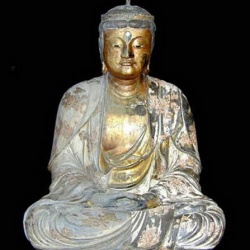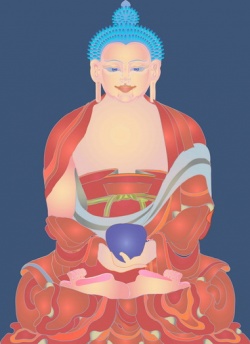Lay arahant
One of the misconceptions about Buddhism, especially early Buddhism / Theravada is that only monks and nuns can become Arahants, fully enlightened.
==Lay Dhamma teachers==
In the Anguttara Nikaya, Book of Tens, Anathapindika and Vajjiyamahita, both lay followers teach the Dhamma by refuting the wrong views of a group of wanderers. At the end of the discourse, the Buddha praises Anathapindika for defending the teaching against misrepresentation. (AN 10.93)
The householder Citta attained to the high spiritual level of anagami (non returner) and taught Dhamma even to monks. (SN 4.282)
==Sotapanna Lay followers==
In the Pali Canon, thousands of lay followers are mentioned as having reached the status of Sotapanna (stream entrant), guaranteed no more than 7 future lives before attaining full enlightenment. The Digha Nikaya, parinibbanana sutta mentions "over 500" lay followers who attained stream entry. The Digha Nikaya, chapter 18 mentions "over 2,400 Magadha followers" who attained stream entry.
==Sakadagami Lay followers==
In the Pali Canon, at least 90 lay followers are mentioned as reaching the status of Sakadagami (once returner), guaranteed to attain enlightenment in the next life as a human or deva. (DN 16)
==Anagami Lay followers==
Over 50 lay people are mentioned as reaching Anagami (non returner), guaranteed full enlightenment in the next existence in the Pure Abodes deva realm. (DN 16)
Majjhima Nikaya 73 mentions over 500 lay followers who have attained Anagami:
Other than bhikkhus, and bhikkhunis. Is there a single lay disciple of Gotama, who wearing white clothes had led the holy life, has destroyed the five lower bonds to the sensual world, and is born spontaneously, not to proceed?'
`Vaccha, not one, not one hundred, not two hundred, not three hundred, not four hundred, not five hundred. There are many more lay disciples of mine, who have destroyed the five lower bonds to the sensual world, and born spontaneously would not proceed,'
`Good, Gotama, wait! Other than bhikkhus, bhikkhunis and lay disciples of Gotama, who wear white clothes and lead the holy life. Is there a single a lay disciple, who wears white clothes, leads the holy life, while partaking sensual pleasures, and doing the work in the dispensation has dispelled doubts. Has become confident of what should and should not be done, and does not need a teacher any more in the dispensation of the Teacher.
Vaccha, not one, not one hundred, not two hundred, not three hundred, not four hundred, not five hundred. There are many more lay disciples of mine, wearing white clothes leadingthe holy life, while partaking sensual pleasures and doing the work in the dispensation have dispelled doubts Have become confident of what should and should not be done and do not need a teacher any more'
==Arahant Lay followers==
The Commentaries mention some lay followers who attained full enlightenment, such as Uggasena who was a lay man with the householder responsibilities with family and work as an acrobat in side shows.
The Milindapanha mentions by implication that lay people can attain full enlightenment:
"If a layman attains arahant-ship, only two destinations await him; either he must enter the Order that very day or else he must attain parinibbàna"
Milindapanha III.19
"You say that if a layman attains arahantship he must either enter the Order that very day or die and attainparinibbàna. Yet if he is unable to find a robe and bowl and preceptor then that exalted condition of arahantship is a waste, for destruction of life is involved in it."
"The fault does not lie with arahantship but with the state of a layman, because it is too weak to support arahantship. Just as, O king, although food protects the life of beings it will take away the life of one whose digestion is weak; so too, if a layman attains arahantship he must, because of the weakness of that condition, enter the Order that very day or die."
Milindapanha III.62
The Milindapanha, which is almost as old as the [rest of (Burmese ed.)] Pali Canon above implies that lay people do/did attain enlightenment. It is just that they all ordained or died within 7 days or less.
Many of the arahants mentioned in the Pali Canon who attained enlightenment were either monks or nuns or ascetics from other traditions, so technically, perhaps the ascetics were not lay followers.
But there is a list of 21 lay followers in AN 6.131 - 151 / 3:450 f; PTS ed AN 6.119-120 who attained full enlightenment. One is listed as a doctor, others as householders, so it does not appear they were all ascetics.
==Likelihood of enlightenment for lay people==
Although there are about 3,000 lay sotapannas mentioned in the Pali Canon, at least 90 sakadagamis, at least 500 anagamis, and about 21 lay arahants mentioned in the Pali Canon, there are far more monastic monks and nuns mentioned as reaching full enlightenment. This appears to be due to the fact of the life of renunciation of monastics, which is more conducive to the highest noble states.
"There are not only one hundred . . . or five hundred, but far more bhikkhunis, my disciples, who by realizing for themselves with direct knowledge here and now enter upon and abide in the deliverance of mind and deliverance by wisdom . . ." (repeated for bhikkhus too, in MN 73)
Although it is unlikely, it is still possible and the distinction between monastic and lay is not quite as sharp as some have believed in the past. Piya Tan's essay, Lamen Saints (see references) goes into greater detail on this subject.
In the previous few centuries the thinking and practice has been that there is a sharp distinction between lay and monastic, with lay people basically serving monastics for their requisites and just hoping for a better rebirth, while the monastics work on their salvation. But Piya Tan and other scholars are now showing that it is more of a blur and that in the time of the Buddha, as evidenced by the Pali Canon, the divide was not that sharp.



